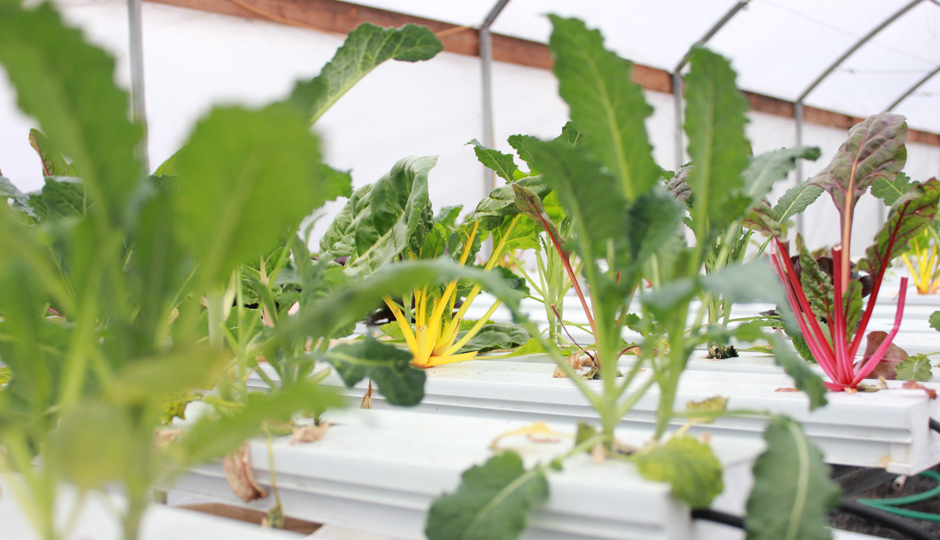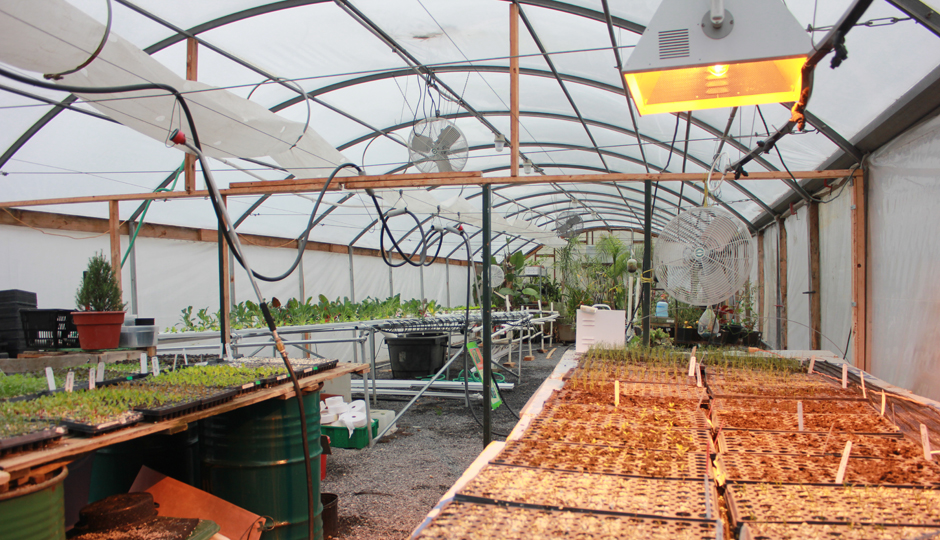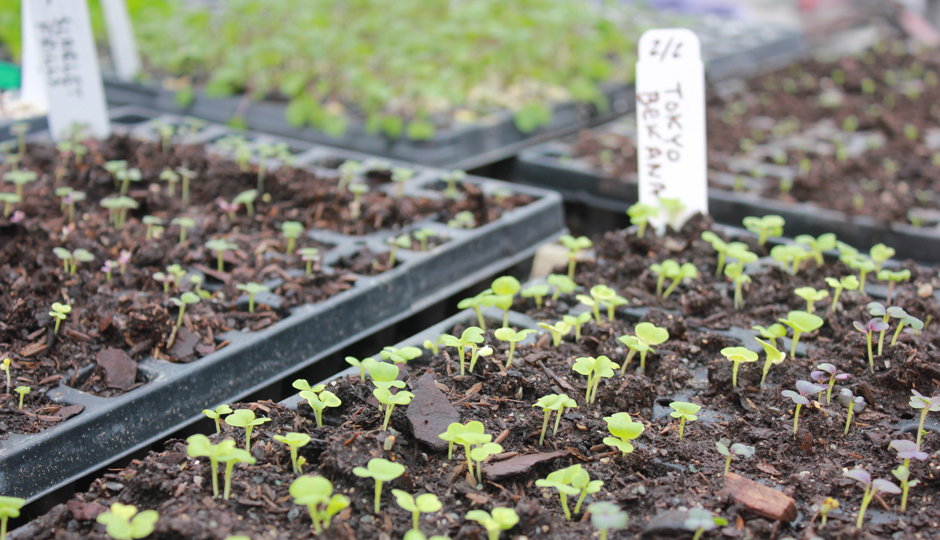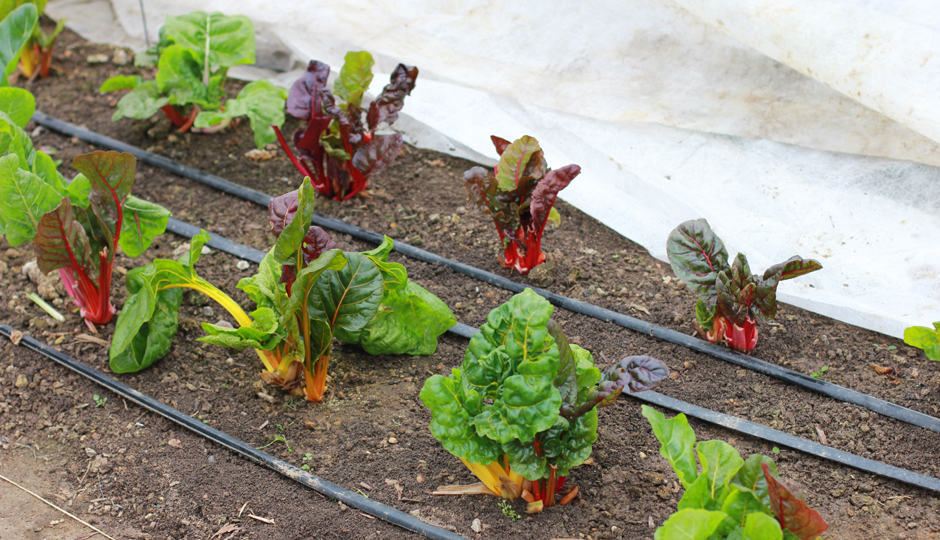How an Urban Farm Keeps Things Growing in the Dead of Winter

Hydroponic greens at Greensgrow | Photo by Lauren McGrath
Last Wednesday, I spent a good chunk of the day outside of my grey cubicle — “grey” is seriously the most accurate description for my cubicle — in what can only be described as an urban oasis. This oasis was Greensgrow Farms’s greenhouse, located on the 2500 block of Kensington’s Cumberland Avenue. The city block is home to the urban farm and its greenhouse, three high tunnels filled with growing veggies, plus about two dozen hens, a pig, a cat and a duck named Ping. Yep, it’s a full house.
I was at Greensgrow — which, unlike the rest of Philadelphia in the dead of winter, was bursting at the seams with life, from hydroponic lettuces to tomato starts — to talk with the urban farm’s sole farmer, Katelyn Repash, about how an urban farm keeps things going (and growing) when mother nature, judging by the lack of leaves on trees around this town at the moment, isn’t capable of doing it on her own. After all, on the day we showed up — when it was snowing, by the way — the farm boasted between 15 and 20 harvestable veggies, from greens like kale and arugula and rumex to carrots to beets to turnips and more, which they sell at their farmstand every other Saturday in the winter.
So, how do they do it? We’re going to show you with lots of photos, so you, too, can squeeze an escape to an urban oasis — albeit a virtual escape — into your week. Check out the photos below.

The Greensgrow greenhouse | Photo by Lauren McGrath
What you see above is Greensgrow’s greenhouse, where the veggie-making magic starts. The farm starts all of their produce from seed, and right now they’ve got all sorts of good stuff coming to life in there, like bok choy, kale, onions and more. The greenhouse is heated to around 60 degrees with a heat lamp that can warm soil up to a nice 80 degrees in the winter, and it’s built with two layers of inflated plastic on the outside to keep the warmth while allowing light in, giving the plants the proper environment to grow.

These cute little guys are seedlings. Eventually, they’ll be planted in the high tunnels (you’ll see those in a second), where they’ll grow into harvestable produce.

Photo by Lauren McGrath
Get this: When Greensgrow first turned what was a vacant lot into the farm back in 1999, they were a completely hydroponic farm. Cool, right? But let’s back up. For everyone who has no clue what a hydroponically grown plant is: As Katelyn explained to me, hydroponic plants, like you see above, are grown using just water (there’s a water pump connected to those planters) that is fertilized with nutrients that the plants would usually get from soil. The plus is that they basically grow themselves, if you get the chemistry of the fertilizer right, and you only have to fertilize them once a week. The minus is that, if your power source goes out for whatever reason, the water stops pumping and your plants die.

One of Greensgrow’s high tunnels | Photo by Lauren McGrath
These are the high tunnels, where seedlings grow into the stuff that’s eventually harvested and sold at Greensgrow’s farmstand. And yes, that is a veggie blanket you see to the right: These high tunnels are outfitted with two layers of inflated plastic for warmth but, unlike the greenhouse, they aren’t heated, so the blankets help keep the veggies warm in the winter months. Most of the plants you see here were planted in October and November in order to get enough growth out of them to continue harvesting all winter long.

Photo by Lauren McGrath
While Greensgrow isn’t certified organic (the process is both expensive and time consuming), they use all organic practices, which means no chemical pesticides. This means that one of Katelyn’s jobs as the farmer is to check all of the crops for aphids, their biggest pest. That takes a lot of time versus just spraying your crops down with something that would keep them away to begin with. This, Katelyn explains, works into the equation when it comes to organic produce prices sometimes being higher than conventional. Interesting right?

Photo by Lauren McGrath
One of Greensgrow’s signature farmstand items is their salad mix (Trust: It is the bomb), so they always have lots of greens growing, but in the summer stuff like eggplant, peppers and tomatoes will be growing on the farm, too. They have the same amount of harvestable crops on the farm in the winter and in the summer, but summer crops can be harvested more often, Katelyn explains. Because they are a pretty small farm with a big CSA program, they aggregate their CSA items from other local farms, most of which use organic practices like them.

Photo by Lauren McGrath
As I mentioned earlier, Greensgrow is all about animals, just so that us city folk can set our sights on them every now and then. They house upward of 20 chickens, but because they are not certified to sell the eggs at the farmstand, those go to the staff. They also have a pig named Milkshake, and an extra pen for visiting animals.

Photo by Lauren McGrath
Can you imagine a job where you get to hug chickens on the daily? Katelyn, doing just that above. And to the right is Ping, resident duck.

Photo by Lauren McGrath
So there you have it, a behind-the-scenes look at how a Philly urban farm, helmed by a single farmer, keeps the produce coming to your plate, even in the dead of winter. You can get your hands on some of their winter produce at the farmstand at their Kensington location this weekend. (Note: They also have a satellite location in West Philly, but that’s currently in the process of moving to a space where Katelyn tells us they might be able to add another high tunnel to the mix and grow even more veggies.)
Like what you’re reading? Stay in touch with Be Well Philly — here’s how:
- Like Be Well Philly on Facebook
- Follow Be Well Philly on Twitter
- Follow Be Well Philly on Pinterest
- Get the Be Well Philly Newsletter


